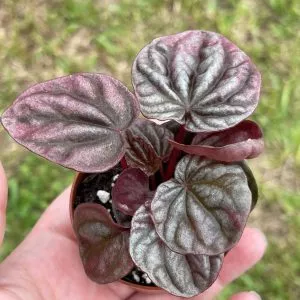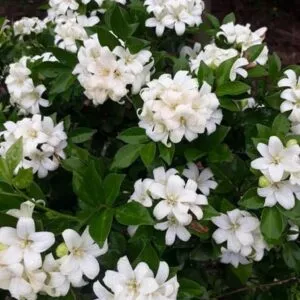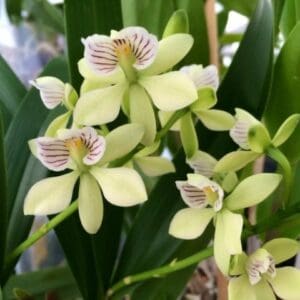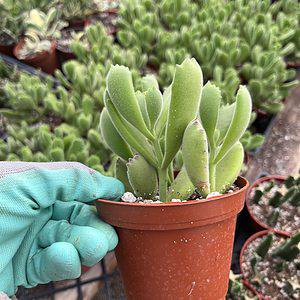No products in the cart.
Table of Contents
The Alocasia black velvet will add a touch of royalty to your living space. Why, as her other name is the Little Queen.
In a small living space, these tropical plants, with their dark green velvety leaves, make for great conversation starters compared to other indoor plants.
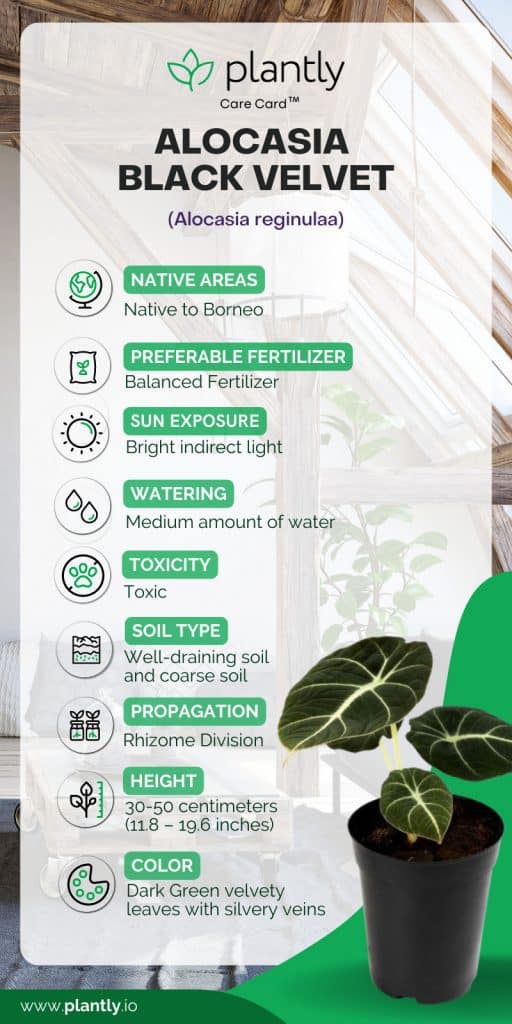
More About Black Velvet Alocasia
The tropical plant makes a perfect houseplant to make a first impression on guests in a small space. The biggest attraction is the Alocasia black velvet leaves.
A fact is that most plants, like the black velvet plants in the Alocasia genus, have large, heart-looking leaves that can also appear arrow-shaped.
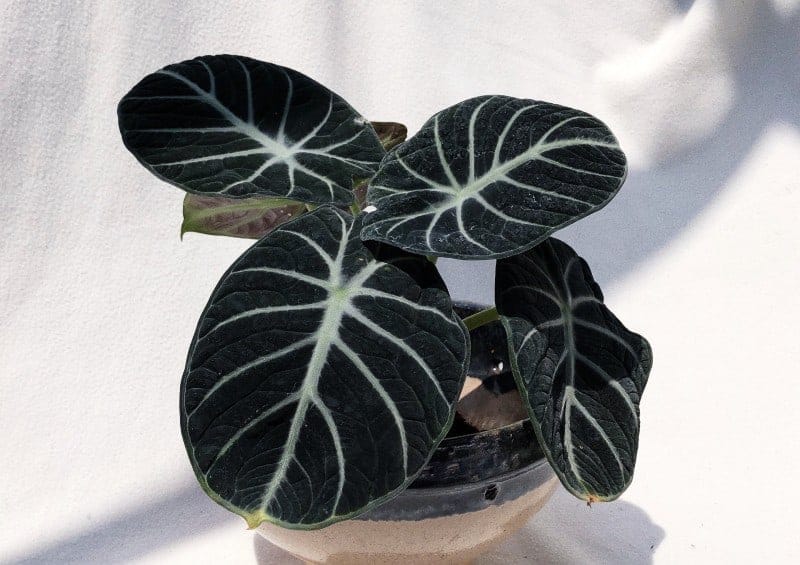
Hence, the common name is elephant ears, but other species also go by this name, like the Colocasia Waikiki and a few others. The indoor plant is more slow-growing and smaller than the other plants in the genus.
It looks like a miniature gem, hence the other name, Jewel Alocasia. One thing is sure: You will not be growing the Alocasia black velvet for a flower indoors, as it rarely blooms inside the home. No, you will be growing it for foliage.
It does bloom a white inflorescence on a pale yellow spathe, but it rarely happens. But the leaves with the dark green, almost black textured foliage is the main attraction. It is an eye-catching evergreen perennial and is not made for people with brown thumbs.
But it does not mean you cannot try caring for this plant. The Alocasia reginula can quickly go dormant or lose some leaves when not given the proper attention. The tropical plant thrives in high humidity and will suit a steamy bathroom. But keeping the plant out of reach is best if you have curious children or pets.
The black velvet is toxic, and all parts of the plant have calcium oxalate crystals that can irritate when eaten. Great, now that you know more about the Alocasia black velvet, let’s look at other available varieties.
Ideal Mix
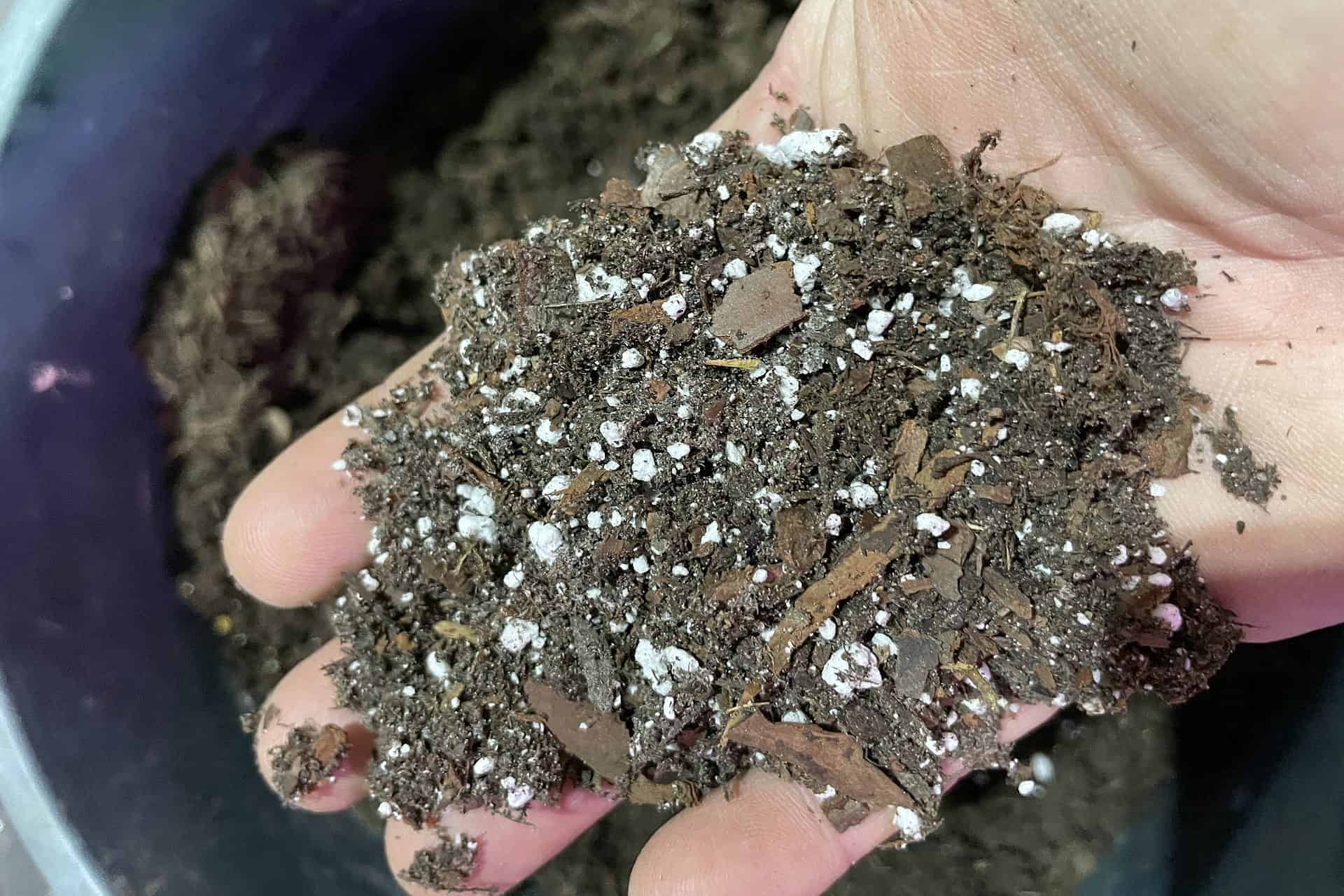
The mix should be coarse and well-draining to maintain the roots aerated at all times, even after they’ve been entirely soaked. Because the roots of this plant are relatively thin and sensitive, particular soil conditions are required, like a tropical mix.
Make it perlite and orchid bark-rich, but always add enough compost. Adding these ingredients to the mix will prevent wet feet from leading to root rot and retain only a tiny amount of water. Although the Alocasia plant prefers moist soil, avoid excessively wet conditions and provide a well-draining airy soil.
The black velvet can develop a robust root system to become mature plants.
How to Water Black Velvet Plant
The plant enjoys moist soil, but be careful watering and allow the top few inches of soil to dry before watering your Alocasia black velvet plant. As quickly as it results in developing root rot, avoid overhead watering on the black foliage that can lead to fungal infections.
The water you use is as essential as it is to leave the soil dry between watering. Alocasia reginula is sensitive to contaminants and minerals in tap water, and it is best to use filtered water instead. So, if you have no choice but to use tap water, leave it standing overnight to help neutralize the chlorine and chloramine.
Pro tip: Rot is a threat to these outdoor plants. Avoid overwatering the plant at all costs. Plant problems such as basal or root rot are caused by wet soil. So keep that in mind.
Lighting Condition
The Black Velvet isn’t as light-hungry as some other aroids. However, that doesn’t mean it doesn’t enjoy being in the dark. If treated as an indoor plant, the black velvet needs bright indirect light to thrive. But not too much light.
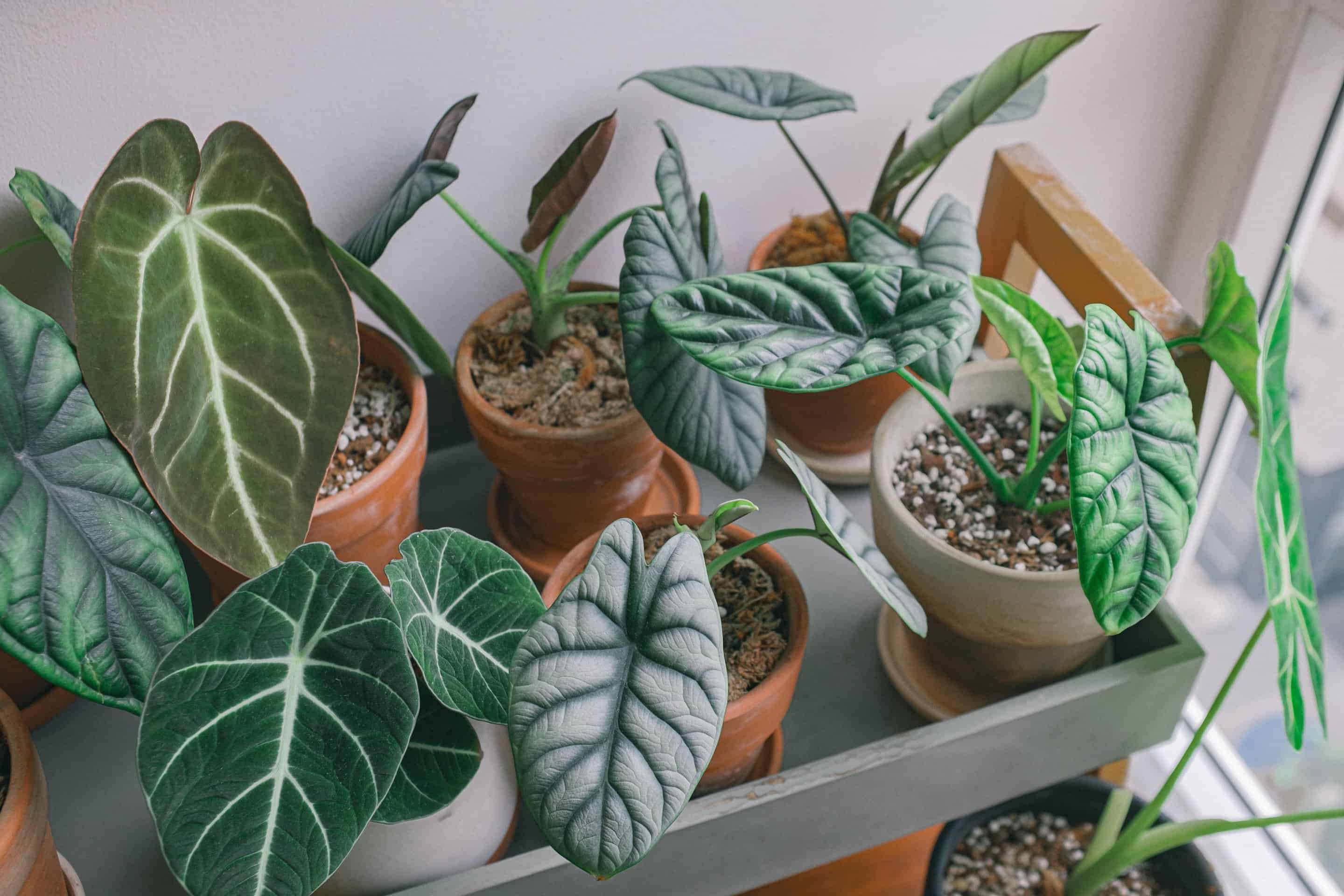
The direct sun should be avoided at all costs, as it might scorch the fragile foliage. On the other hand, their dark leaf coloration implies that they can somewhat survive with decreased light levels. So go ahead and try something new and observe how your plant reacts.
Pro tip: For assured indirect light, North-facing windows are best. However, East-facing windows can work as long as the morning sunshine isn’t too bright.
Temperature & Humidity
This plant thrives in a temperature range of 55 to 80 degrees Fahrenheit (12.7 -26.6 degrees Celsius). Alocasia reginula isn’t a cold-hardy plant and is best placed in a warm location. So, keep your black velvet Alocasia away from a cold window.
Pro tip: When temperatures drop too low, your black velvet Alocasia might go dormant, while freezing temperatures, on the other hand, destroy the plant’s leaves.
High humidity is required for proper Alocasia Black Velvet care – about 60%-70%. Although some humidity-lovers are content with overly moist soil, the Dark-leaved jewel thrives best in a steamy atmosphere.
Don’t worry if you can’t meet these requirements. You can use a humidifier or place it in the bathroom or anywhere else in the house where the humidity is higher than the rest. A pebble tray can also meet the plant’s humidity requirements.
Pro tip: Avoid soaking the leaves for long periods. Fungus and leaf rot may develop as a result of this.
Velvety Alocasia Fertilizer
Alocasia Black Velvet is a light feeder that does well with only a little fertilizer during the growing season. As important as it is to avoid direct sunlight and overwatering, try to avoid overfertilizing. Feed with a balanced fertilizer once a month. If using an all-purpose fertilizer, use half-strength.
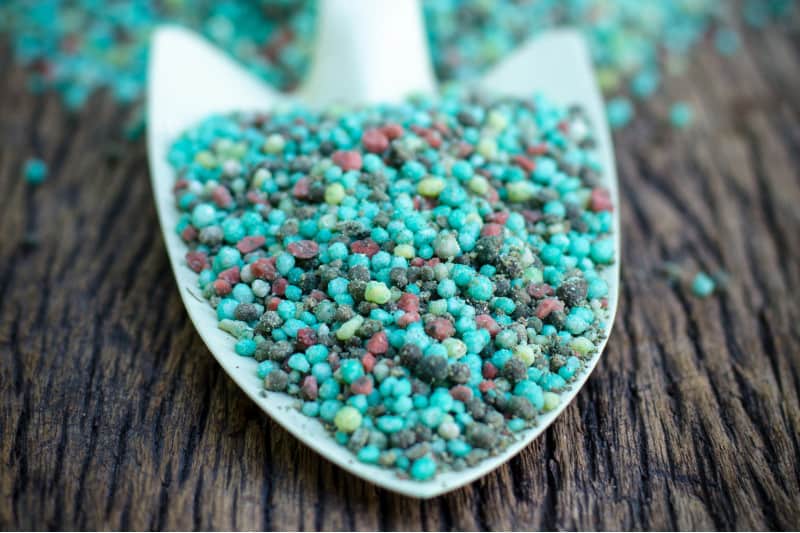
Don’t use too much fertilizer to avoid fertilizer burn on the plant’s leaves. Because the plant is dormant during winter, you should not fertilize it.
Pro tip: If you don’t want to overfertilize your plant and ensure it gets all the nutrients it needs, you can use an organic fertilizer once a month during the growing season or when you observe new growth.
Propagation
The Alocasia’ Black Velvet’ is most successful regarding rhizome division. The plant is ready for propagation during its growing seasons (Spring or Summer).
Here is the process of how to propagate the Alocasia’ Black Velvet’ plant:
- Remove the Alocasia’ Black Velvet’ from its pot and gently shake off any excess soil around the roots. Examine the plant’s root system to see if it is healthy.
- Examine the rhizome system and cut those that resemble ginger. To remove the rhizome of your choosing, use a clean knife and make sure you’re wearing gloves.
- Prepare the potting mix to provide the ideal environment for the new plant to thrive. An intelligent choice is to combine ordinary potting soil with coco coir.
- Place your rhizome in the soil and give it a soft drink once it’s ready. Place your new plant where it will receive bright yet indirect light. Then, just like you did with the mother plant, repeat the process.
-
$35.99Sold By: Succulent Oasis
In stock
Mature Succulent Plant Echeveria ‘Hortencia’ Hybrid.
Rated 4.84 out of 5 based on 352 customer ratings00Sold By: Succulent Oasis -
$5.99Sold By: BubbleBlooms
In stock
Red Peperomia caperata, Red Emerald Ripple, Frost, Platinum, limited, in a 2 inch pot super cute
Only 991 available and it’s in 1 people’s basketRated 4.81 out of 5 based on 279 customer ratings01Sold By: BubbleBlooms -
$20.00Sold By: Soul Peace Gardens
In stock
Soul Peace Bundle – Baby Toes Succulent – Fenestraria Rhopalophylla
Only 1 available and it’s in 1 people’s basketSold By: Soul Peace Gardens
Growth Zone
Only USDA Zones 10a and above are suitable for growing them outdoors all year.
Potting
Alocasia Black Velvet thrives in smaller containers. If you want to repot it, the plant should be as active as possible during the repotting process. Repotting should be done every 1-2 years, depending on how much the plant grew the previous season. Allow it to root-bound a little so she can adjust to the new pot.
Alocasia Varieties and Similar Plants
There are approximately 97 species of Alocasia plants. Even if we want to display them all, we just can’t. However! We provide examples of Alocasia species or varieties similar to the Alocasia’ Black Velvet.” And I know you will also love them. But if you want to see more of the others, check out our Alocasia collection.
Alocasia baginda ‘Dragon Scale’
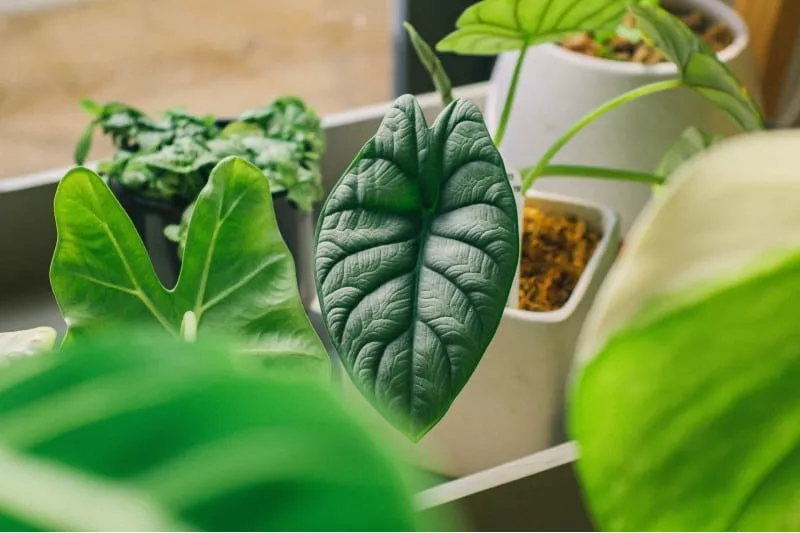
With their ribbed structure, the leaves of the Alocasia Dragon Scale resemble enormous scales. The contrast between the silvery green backdrop and the deep dark green markings at the front is stunning.
Alocasia cuprea ‘Red Secret’
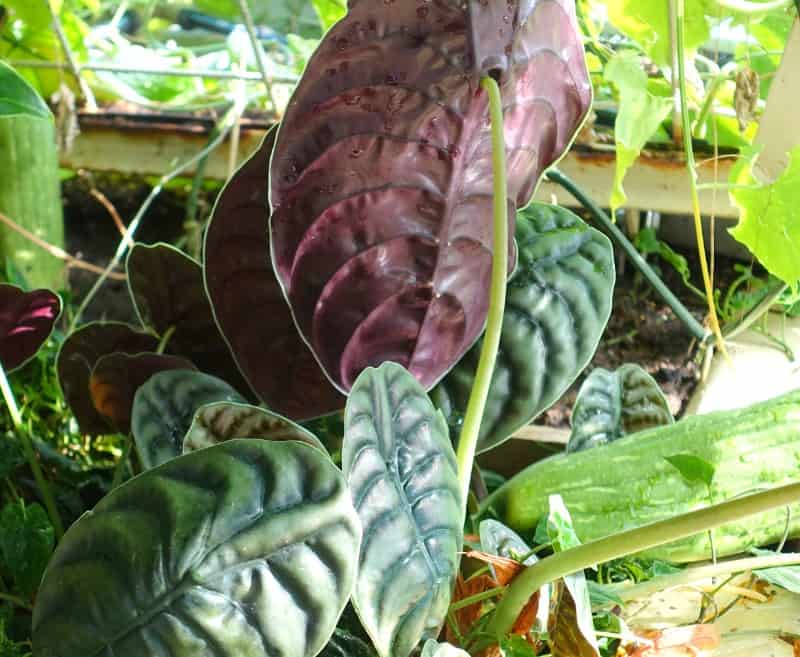
It’s grown mainly for the leaves, which are significant, oval, and metallic in appearance, ranging from dark green to crimson. The leaves’ undersides are a vivid purple, creating an eye-catching visual wonder.
Alocasia micholitziana’ Frydek’
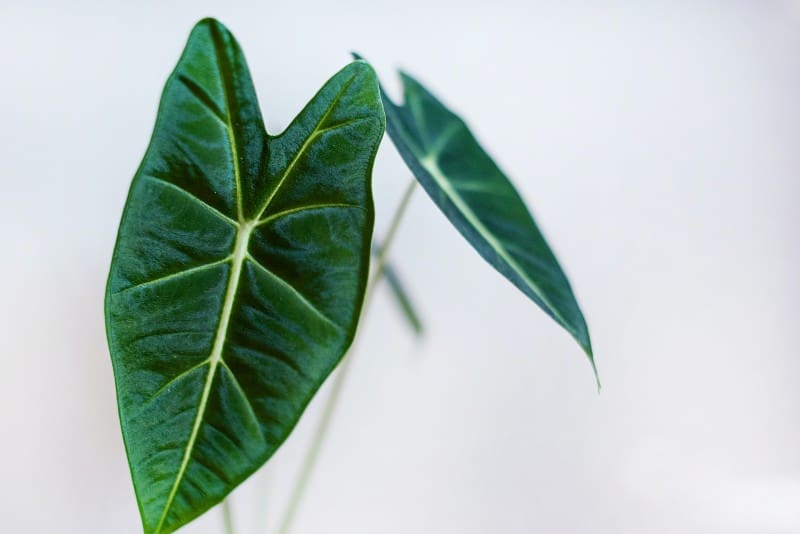
The distinctive arrowhead design complements the velvety velvet leaf texture. The leaves of this plant are dark green to black, with conspicuous white lateral veins.
Black Leaf Alocasia Diseases & Pests
As much as we want a healthy plant, pests are there to bug it—the same as Alocasia Black Velvet. However, if given appropriate care, these posters are rare. But we’ll also give you the care tips, just in case.
Insects and Pests
One of the most prevalent pests identified on the plant is mealybugs and spider mites. Mealybugs pierce the plant’s protective outer layer and feast on its nutrients. They can spread illnesses as well as make the leaves look ugly.
You should look for spider mites if you find white dots on your leaves. Spider mites thrive on the underside of the leaves. Remove any spider mites as soon as possible. First, try hosing or rinsing them or using a soapy water mixture.
If that doesn’t work, a mild pesticide may be required. Neem oil can also be used to repel pests naturally.
Root Rot and Overwatering
The roots are rotting if you notice your Alocasia black velvet withering or looking a bit sick and squishy around the base. This is a problem that many plants have, and it’s caused by too much water in the soil.
This suffocates the roots and plugs the air pockets, preventing them from absorbing water.
Fungal diseases thrive in the wet atmosphere; the plant will most likely die if not handled properly. Ensure the soil is moist but not saturated, there is no standing water, and the plant is not sitting in a plate of water.
Frequently Asked Questions
When it comes to Alocasia black velvet care, there are curling leaves resulting from standing in direct sunlight. Even worse is when the foliage starts creasing at the edges, and it is best to move your plant to a spot where it can receive bright indirect sunlight. The same can happen when your plant gets overly dry.
As with curled leaves when it comes to Alocasia black velvet care, yellowing leaves, it happen when your plant stands in water and is a sign that you need to cut back on watering. Also, check the drainage to ensure that excess water drains from the soil.
While overwatering is a considerable concern with Alocasia black velvet care, another problem is when they do not get enough water, resulting in brown leaf tips. The same can happen with overfertilizing.
The little princess is a slow grower and can take up to five years to become a mature plant. Even fully grown, they rarely reach more than 18 inches.
You rarely find the black velvet Alocasia in the wild, native to Borneo. Still, with the growing popularity, you see more nurseries cultivating the plant for the commercial market. Still, it remains a rare species and is not easily found in a local garden center.
The Alocasia green velvet is another prevalent plant known as the Alocasia micholitziana’ Frydek.’ It has dark green arrow-shaped leaves with white veins and grows faster and taller than the Alocasia black velvet.
Whether you want to buy, sell or simply reach out to other plant enthusiasts, Plantly is the right place to be!
-
Free Shipping$39.99Sold By: Aloha Hawaii Orchids
$44.99In stock
Orchid Encyclia Radiata Fragrant Plant
Rated 4.65 out of 5 based on 268 customer ratings00Sold By: Aloha Hawaii Orchids -
$9.99Sold By: Cacti and Exotica
In stock
Cactiandexotica | Cotyledon tomentosa | Bear Paw
Rated 4.98 out of 5 based on 59 customer ratings01Sold By: Cacti and Exotica -
$13.99Sold By: BubbleBlooms
In stock
Variegated Hoya Kerrii Heart / Sweetheart Plant / Mothers day plant / Hoya Plant / Heart Shaped Succulent / Heart Hoya / Live Plant Rare
Rated 4.81 out of 5 based on 279 customer ratings01Sold By: BubbleBlooms -
Free Shipping$24.99Sold By: Gar-Zen Botanical Design
In stock (can be backordered)
Mexican Flame Vine Best Pollinator Ships Free.
Only 110 available and it’s in 1 people’s basketRated 4.86 out of 5 based on 49 customer ratings00Sold By: Gar-Zen Botanical Design

